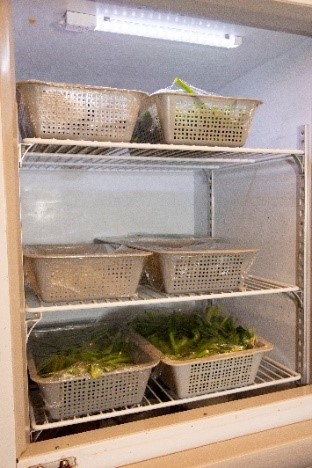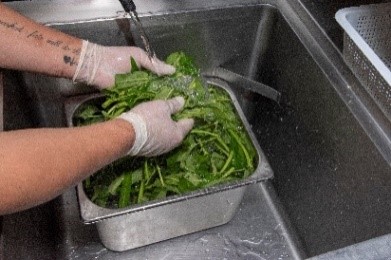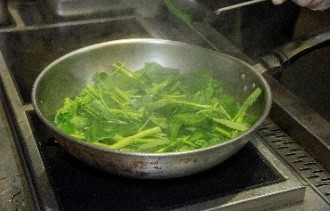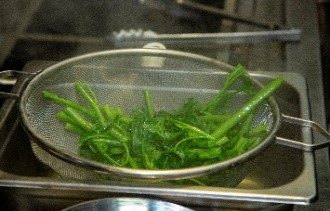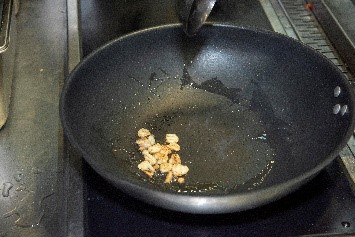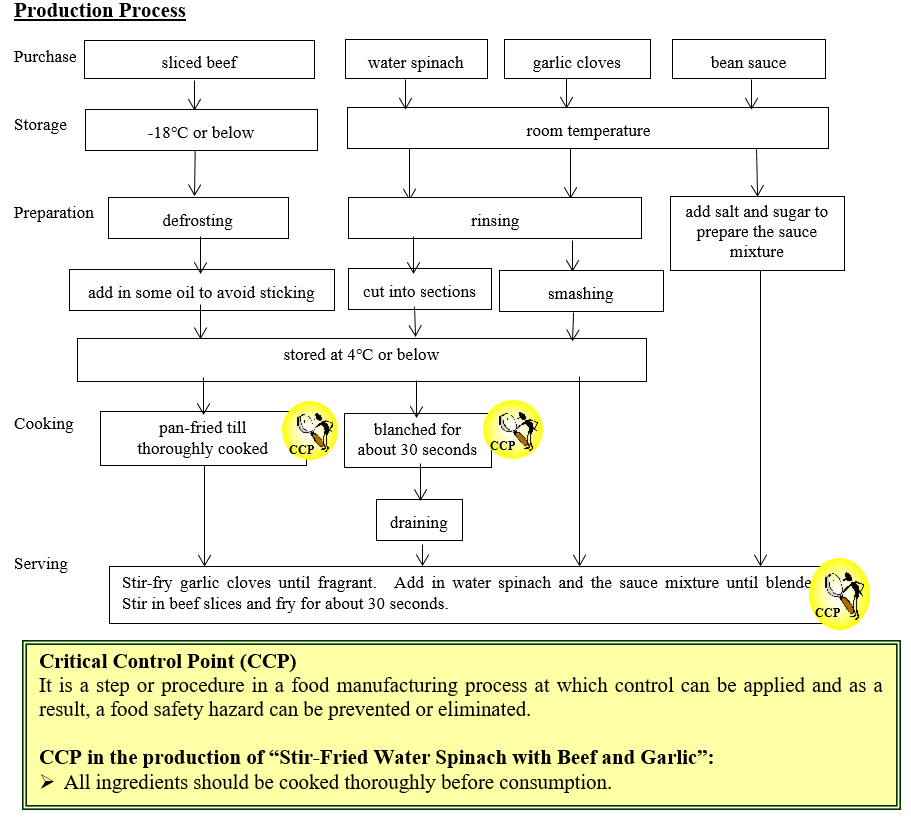
Feature Article
Updates on Action against African Swine Fever
In May 2019, two cases of African Swine Fever (ASF) were reported at Sheung Shui Slaughterhouse (SSSH). Following that, ASF virus was detected in samples collected from three dead pigs at the SSSH on 3 September 2019. In light of Hong Kong's unique situation and the experience gained from two reported cases, the Centre for Food Safety (CFS) has adopted the following new control measures against ASF.
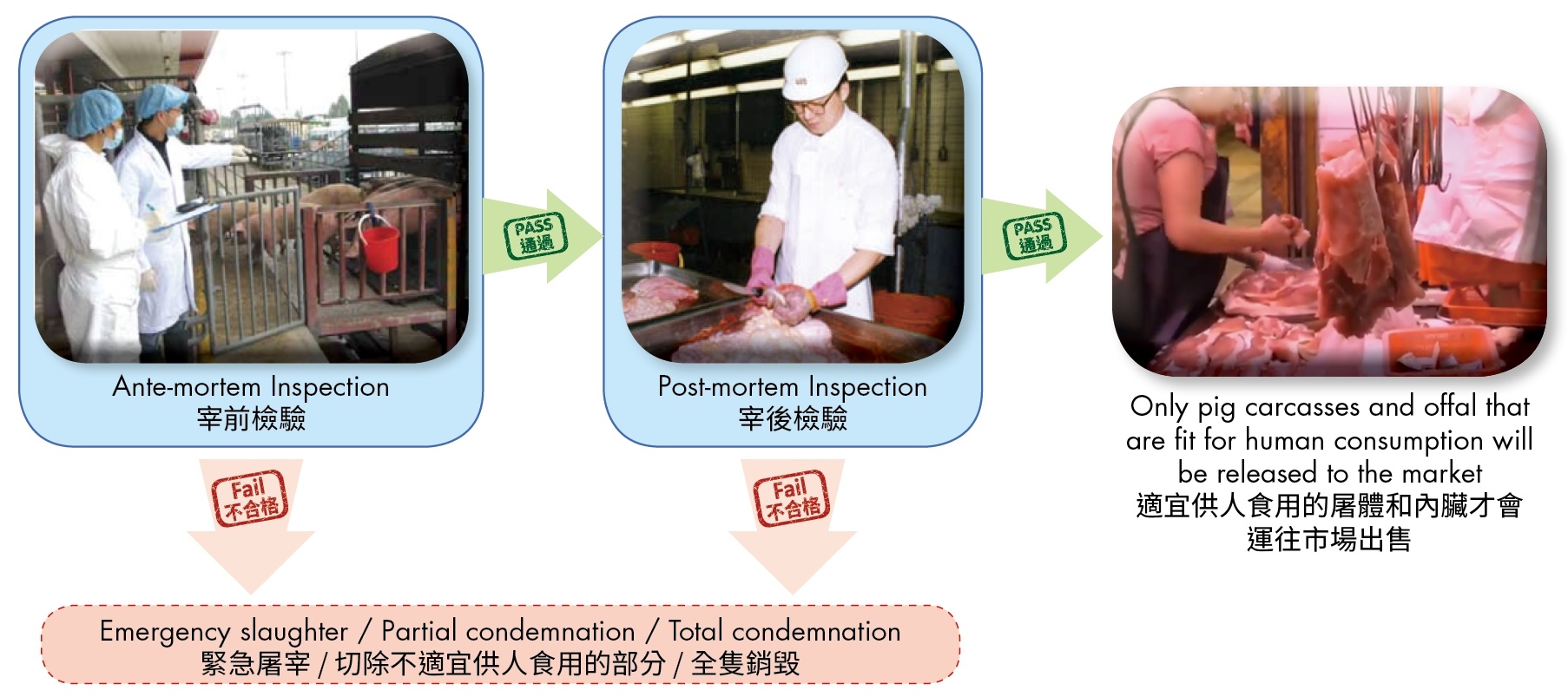
Figure: All local and imported pigs have to undergo stringent ante-mortem and post-mortem inspections in slaughterhouses to ensure that they are fit for human consumption before supply to the market.
Hong Kong pork supply
Unlike its overseas counterparts, the pork market of Hong Kong comprises not only frozen and chilled pork but also warm meat from freshly slaughtered pigs. Traditionally, the warm meat market relies heavily on import.
ASF challenges faced by Hong Kong
"China is going to deal with this African Swine Fever for many years to come", remarked by Dr Matthew Stone, Deputy Director-General of the World Organisation for Animal Health (OIE) at the 87th OIE General Assembly. With Hong Kong's heavy reliance on import of live pigs and pig products, even though a range of preventive measures have been put in place to guard against ASF from the sources and along the supply chain, the risk of further occurrence of ASF cases remains.
Actions against ASF
While ASF does not infect humans or pose food safety risks, it can have devastating impacts on the local pig rearing trade if it establishes its foothold in Hong Kong. After the first two ASF cases in May, the Government, taking into account the views of local and overseas experts and with the support of the live pig trade, has imposed a daily clearance arrangement whereby all live pigs are slaughtered within 24 hours upon admittance into the slaughterhouse. Lairages in different areas of the slaughterhouse are cleared out for thorough cleansing and disinfection on a daily basis. As the time for pigs staying in the slaughterhouse is short, and with enhanced cleansing and disinfection of pig carrying vehicles, the new arrangement can significantly reduce the risk of ASF spreading in Hong Kong. In addition, the Agriculture, Fisheries and Conservation Department has implemented various preventive measures against ASF, including, among others, requesting pig farmers to adopt proper biosecurity measures, strictly controlling the vehicles and personnel entering and leaving pig farms, strengthening the periphery of pig farms to prevent wild pigs from entering the farms, advising pig farmers to forbidden their staff from bringing pork and pork products into the farms, enhancing the cleansing and disinfection of vehicles and personnel entering and leaving pig farms, as well as carefully handling pig excrements.
At the second meeting of the Standing Group of Experts on ASF organised by the OIE and the Food and Agriculture Organization of the United Nations in July 2019, experts had an in-depth discussion on the prevention and control measures against ASF. They opined that each region should take its own situation, such as the stocking density, demand and supply of live pigs, etc. into consideration in formulating effective and practical local control measures. Given that both the SSSH and the Tsuen Wan Slaughterhouse have already implemented the daily clearance arrangement, the experts (including those the Government had consulted earlier) considered that the possibilities of infection and spread of the virus to other pigs in Hong Kong have been largely minimised. Therefore, if ASF virus is detected in pigs in a local slaughterhouse, closure of the slaughterhouse and culling of all pigs present may not be necessary. After all, only pigs that are fit for human consumption are released to the market after stringent ante-mortem and post-mortem inspections in the slaughterhouse. To ensure food safety, pork should be well cooked before consumption.
Key points to note
- ASF does not infect humans and has no food safety concern.
- Enhanced preventive measures against ASF have been implemented, which largely minimise the possibilities of infection and spread of ASF virus to other pigs in Hong Kong.
- If ASF is detected in a local slaughterhouse, closure of the slaughterhouse and culling of all pigs present may not be necessary. Only pork that is fit for human consumption will be released to the market.
Readers' Corner
Get to Know Industrially-produced Trans Fats
What comes to you mind when "trans fats" (TFAs) is mentioned? The lip-smacking cream soup with puff pastry? The flaky beef and cheese pie, or some kind of fats contributing to clogged arteries?
What are TFAs?
TFAs are a type of unsaturated fatty acids. While a tiny percentage (up to 6% of a product's fat content) of TFAs which occur naturally in the guts of ruminant animals may be present in meat and dairy products from ruminants, the vast majority of TFAs (up to 60% of a product's fat content) are artificial fats used in food production, i.e. industrially-produced TFAs (IP-TFAs). In the examples of cream soup with puff pastry and beef and cheese pie shown below, both types of TFAs may be found.
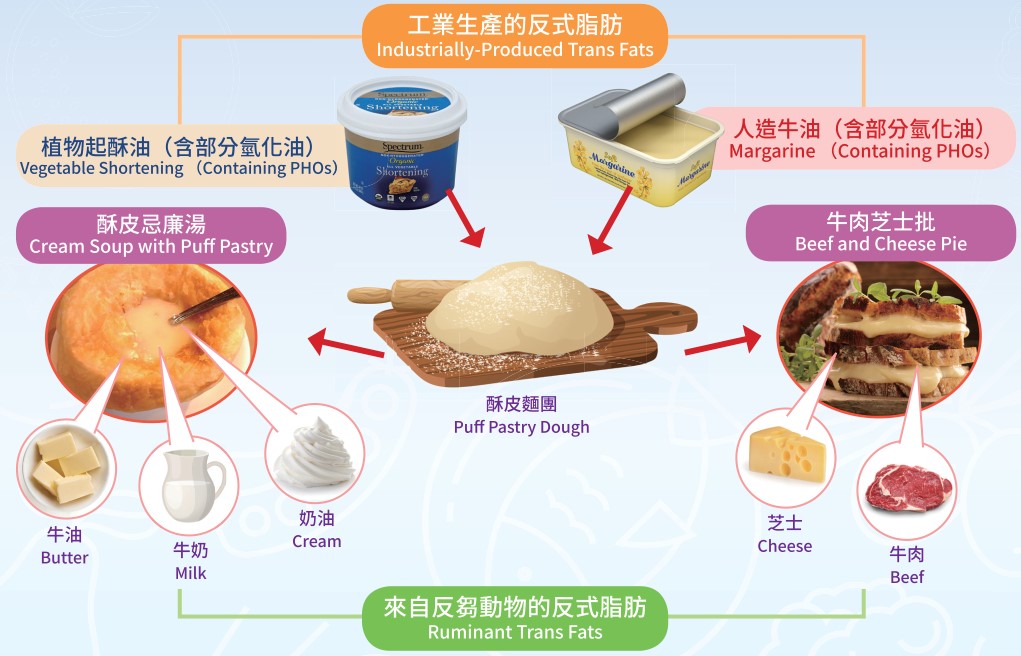
Figure: TFAs may be hidden in processed foods as ruminant-TFAs (usually of a small amount) and IP-TFAs (of a large amount if ingredients containing partially hydrogenated oils (PHOs) have been used).
What are IP-TFAs?
Most vegetable oils are in liquid form at room temperature. If hydrogen is added to oils (in a process called hydrogenation), they will become more solid or "spreadable". PHOs can be found in margarine or vegetable shortening.
PHOs have their commercial applications and uses in food technology. They make food products more appealing by enhancing their organoleptic properties and texture, with the additional advantage of a prolonged shelf life and increased tolerance to repeated heating. PHOs can better withstand repeated heating without breaking down, making them ideal for frying fast food, baking food and processing snack food.
What foods contain IP-TFAs?
IP-TFAs and PHOs are found in a variety of food products. TFAs are detected in bakery products (e.g. bread, cakes, cookies), deep-fried foods (e.g. French fries, fried chicken, deep-fried dough sticks) and margarine/margarine-like spreads.
How do TFAs doubly harm our cardiac health?
TFAs are the worst type of fats for the heart and blood vessels as they affect the blood cholesterol levels, resulting in an increase of "bad" cholesterol and a decrease of "good" cholesterol.
Excessive "bad" cholesterol in the body will build up inside blood vessels to form plaques. Over time, the plaques can cause blood vessels to narrow, blocking blood flow to and from the heart and other organs. If arteries are clogged, it will greatly increase the likelihood of heart attack, stroke and even death. Furthermore, TFAs induce inflammation which can affect the normal functioning of the inner linings of blood vessels. All these problems pose threats to our cardiac health. On the contrary, "good" cholesterol absorbs cholesterol in the blood and carries it back to the liver for disposal.
In summary, IP-TFAs are man-made harmful compounds found in foods, fats and oils. TFAs can clog arteries and increase the risk of coronary heart disease.
How low should the intake of TFAs be?
The World Health Organization suggests that IP-TFAs are not part of a healthy diet and should be avoided. The daily TFA intake for an adult should be less than 1% of the total energy intake, i.e. fewer than 2.2. grams per day for a 2,000kcal diet.
How can consumers avoid foods with IP-TFAs?
TFAs are usually present in bakery products, deep-fried foods and margarine/margarine-like spreads. Consumers should maintain a balanced diet and reduce the intake of IP-TFAs by consuming these foods less often. To avoid foods with TFAs, consumers can check the TFA content of foods available online in designated reports and through the Nutrient Information Inquiry System.
The Nutrition Labelling Scheme which came into force in July 2010 mandates the labelling of TFA content on prepackaged foods. Consumers can choose foods without TFAs with reference to the information on the food label (e.g. nutrition label, ingredient list and TFA-free claim). More attention should be paid to foods marked with words such as "hydrogenated", "partially hydrogenated", "shortening" or "margarine".
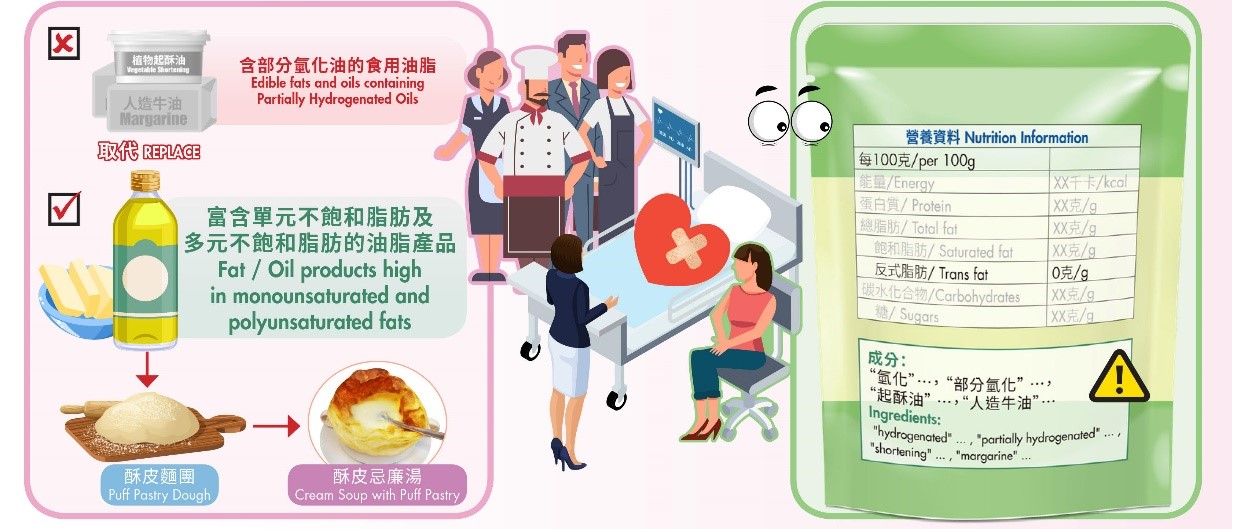
Figure: Traders (by replacement) and consumers (by reading the food label) both play a role in protecting the heart against IP-TFAs.
Concerted efforts required to protect cardiac health against IP-TFAs
The food industry can change the manufacturing practices to eliminate IP-TFAs in food products, while consumers may try to obtain more food information before making their choices. The CFS has been adopting a multi-pronged approach to reduce the IP-TFA intake of the population. Through promoting the replacement of IP-TFAs with healthier fats/oils and raising the awareness of the negative health impacts of TFAs among various stakeholders, we can eliminate IP-TFAs from the food supply chain to protect cardiac health.
News on New Dishes
Stir-fried Water Spinach with Beef and Garlic
Home-style dishes are usually easy to cook, healthy and tasty. The cooking steps look simple, but it requires some skills to make the food taste good and look appealing. In this issue, Mr Cheng, Head Chef of Lime Fish (a signatory of the Food Safety Charter), will demonstrate the preparation of a homely dish "Stir-fried Water Spinach with Beef and Garlic". The recipe is easy to learn and practise. Let's give it a try.
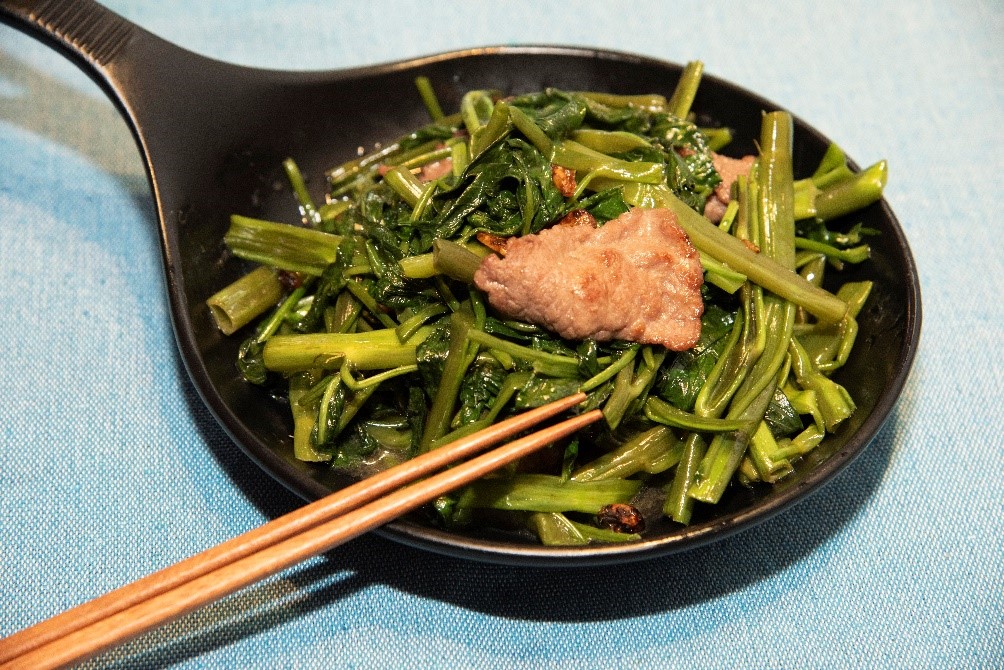
| Preparation Steps | Small Tips, Big Wisdom | |
|---|---|---|
|
Receiving |
Purchase ingredients such as water spinach, sliced beef, garlic cloves and bean sauce from approved and reliable suppliers |
Check the inventory to decide on the quantity of purchase. Upon receipt of the ingredients, examine closely to ensure their freshness. Sliced beef should be kept in a freezer at -18℃ or below. Place water spinach, garlic cloves and bean sauce on shelves in an orderly manner. The ingredients should be consumed within their shelf life. Stick to the "first-in-first-out" principle and use the oldest stocks with the shortest shelf life first. |
|
Defrosting |
Defrost marinated beef slices in a chiller at 4℃ or below. Stir in some cooking oil to the thawed beef slices to prevent them from sticking together. Cover the beef slices with plastic wrap and put them back into the chiller. |
Handle and cook thawed meat as soon as possible to avoid bacterial growth. |
|
Rinsing and Cutting |
Soak water spinach and garlic cloves in water three to four times. Cut water spinach into sections. Smash garlic cloves. Cover the ingredients with plastic wrap and keep them in the chiller. |
Rinsing vegetables thoroughly under running water can effectively reduce the risk of pesticide intake. Wearing disposable gloves in food preparation is a convenient way to ensure food hygiene. |
|
Blanching |
Blanch water spinach in boiling water for 30 seconds, take out and drain. |
Draining water spinach can prevent oil splattering when stir-frying the vegetable and keep the sauce thick. |
|
Pan-frying |
Heat up the pan. Add in beef slices and fry until thoroughly cooked. Set aside. |
Using a smaller oil spoon can prevent excessive use of oil. |
|
Stir-frying |
Stir-fry garlic cloves until fragrant. Add in water spinach and the sauce mixture of bean sauce, salt and sugar until blended. Stir in beef slices and fry for about 30 seconds. |
The use of natural ingredients (e.g. garlic cloves) can reduce artificial seasonings. The food should be consumed as soon as possible. Cooked food left at room temperature for more than four hours can allow bacteria to grow and should not be consumed. |

Mr Cheng has been working in the culinary industry for more than 20 years. He is a veteran cook specialising in Thai cuisine. He shared with us the following tips of preparing Stir-fried Water Spinach with Beef and Garlic:
- Refrain from using artificial seasonings, which are higher in sodium. Using natural ingredients (e.g. garlic cloves) can enhance the flavour, and they are better for health.
- Choose beef with a low fat content (e.g. beef rump). It is a healthy ingredient for a delicious dish.
- Bear in mind the balanced diet principle of "eating more vegetables and less meat" when preparing this nutritious and fibre-rich dish.
Food Safety Plan Corner
Stir-fried Water Spinach with Beef and Garlic

Ingredients:
Water spinach, sliced beef, garlic cloves, bean sauce
Steps:
- Take out bean sauce from the dry goods shelf and add in salt and sugar to prepare the sauce mixture.
- Take out water spinach and garlic cloves from the dry goods shelf and rinse them thoroughly under running water. Cut water spinach into sections. Smash garlic cloves. Keep these ingredients in the chiller.
- Take out marinated beef slices kept in the freezer at -18°C. Stir in some cooking oil to thawed beef slices to prevent them from sticking together. Cover the beef slices with plastic wrap and put them back into the chiller.
- Blanch water spinach in boiling water for 30 seconds, take out and drain.
- Heat up the pan. Add in beef slices and fry until thoroughly cooked. Set aside.
- Stir-fry garlic cloves until fragrant. Add in water spinach and the sauce mixture until blended. Stir in beef slices and fry for about 30 seconds.
Production Process
Briefing of Activities
Food Safety Day 2019
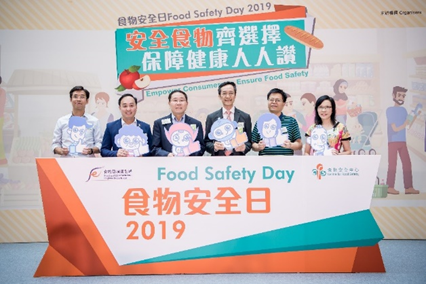
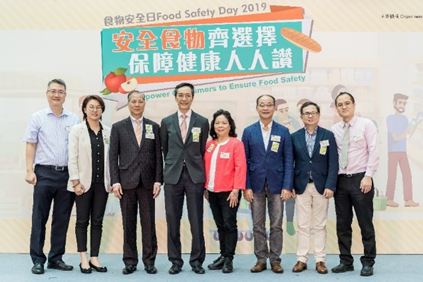
The CFS organises the Food Safety Day annually with the aim of promoting tripartite collaboration among the Government, the food trade and the public. With the theme of "Empower Consumers to Ensure Food Safety", the event this year is designed to raise public awareness of the shared responsibility of the Government, the trade and consumers in safeguarding food safety.
The kick-off ceremony of Food Safety Day 2019 was held on 2 June (Sunday). On that day, the CFS arranged a series of activities including exhibitions, sharing sessions and game booths to encourage public engagement in food safety issues. In his opening address, Dr Samuel Yeung Tze-kiu, Consultant of the CFS, called upon the public to pay more attention to food safety information and make informed choices.
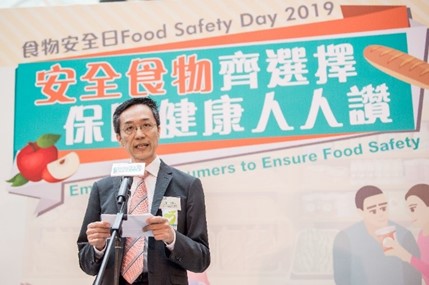
Dr Samuel Yeung delivered a speech at the kick-off ceremony.






The CFS will conduct a series of talks on related topics from July to December 2019. The talks will introduce the possible health hazards posed by some kinds of high-risk foods (e.g. raw foods and wild plants/mushrooms) and share tips on how to read nutrition labels and select food safety information, so as to enhance public knowledge of food safety.
Other topics, including an introduction to the Hazard Analysis Critical Control Point (HACCP) System, the threats of antimicrobial resistance (AMR), the Five Keys to Food Safety and nutrition labels, will also be covered by the talks to promote healthy eating habits so that everyone can enjoy food in a safe and healthy way.
Upcoming Activities
Hong Kong Brands and Products Expo (2019)
he Hong Kong Brands and Products Expo is an annual flagship event in the city. The 54th Expo will be held between 14 December 2019 and 6 January 2020 at Victoria Park. As in the previous years, the CFS will participate in this mega event organised by the Chinese Manufacturers' Association of Hong Kong to disseminate food safety messages to the public.
During the Expo, CFS staff will set up a booth on site to promote food safety to the public by distributing publicity leaflets, pamphlets and souvenirs. They will also explore food safety issues with participants in a lively and interesting manner through on-stage interactive redemption games.
You are welcome to visit the coming Expo to learn more about food safety.


Food Safety Q&A
Fish Contain Heavy Metals. It is Better Not to Eat Fish.
Mrs YU went shopping at a market one afternoon. She walked past Ah Wai's fish stall.
Wai: Hello, Mrs YU. We have very fresh fish today. The fish's eyes are bright and clear. Do buy some and cook for your grandson.
YU: Oh no, who dares to eat fish these days? Not long ago an environmental report noted that some industrial wastes, including mercury, were discharged into the sea. Mercury is a heavy metal that can accumulate in fish through food intake. I've heard that eating fish contaminated with mercury can result in impairment of intelligence.
Wai: Mrs YU, I'm afraid you only have piecemeal knowledge of it. The sea is indeed polluted. What's more, marine microorganisms can convert mercury into methylmercury, which is more toxic and can accumulate up the food chain. However, most common fish species seen in the market have very low levels of methylmercury. It is predatory fish like shark, swordfish, marlin, alfonsino and some tuna species that usually contain high concentrations of methylmercury. So, don't panic. You shouldn't be afraid of eating fish.
YU: You said this because you are a fishmonger. How can I stop worrying?
Wai: (taking out a printout) Take a look at this. It is from the website of the CFS. My son saw it and printed it out for me. Read here. It is mentioned that fish contain many nutrients that we need, such as omega-3 fatty acids, docosahexaenoic acid, or DHA, and eicosapentaenoic acid, or EPA. These are all beneficial for the development of the brain.
Wai: (pointing at the printout) Here's some advice from the CFS to the public:
- Pregnant women, women planning for pregnancy and young children should avoid eating large predatory fish and fish which may contain high levels of methylmercury.
- Fish contain many essential nutrients, such as omega-3 fatty acids and high quality proteins. Moderate consumption of a variety of fish is recommended for a balanced diet.
- Maintain a balanced and varied diet so as to avoid excessive exposure to metallic contaminants from a limited range of food items.
YU: I see. The CFS webpage is really informative.
Wai: Yes, it is. We can really learn something from it. To be frank, it's difficult to avoid environmental pollution. But we can't just refrain from eating everything, right? In fact, if we choose wisely and follow the advice of the CFS on fish consumption, there's no need to worry about excessive exposure to metallic contaminants.
YU: (pointing at the fish table) I haven't eaten fish for quite some time. Alright. I'll take this golden thread.
Wai: It's really fresh. Good pick!
Truth Against Fallacy
Are Expired Foods Still Safe to Eat?
Have you ever sniffed at a food item that has just passed the date marked on the food label and wondered if it is still safe to eat? Actually, the "best before" or "use by" date on the food label may give you some clues.
What is the difference between "Best Before" and "Use By" dates?
According to the Food and Drugs (Composition and Labelling) Regulations (Cap. 132W), both "best before" and "use by" dates are the compulsory form of date marking on prepackaged foods.
The "best before" date is related to food quality such as taste, texture, aroma and appearance. If the food is stored properly, it can reasonably be expected to retain its specific properties up to and including the specified date. In general, foods that do not contain and/or support the growth of food poisoning bacteria (e.g. canned foods and frozen foods), as well as foods that require cooking or other processing to reduce or eliminate food poisoning bacteria before consumption (e.g. fresh meat), may carry a "best before" date. A "best before" date may also be applied to foods, such as plain bread, that obviously spoiled (e.g. mouldy, rancid or stale) before posing a food safety risk to consumers. Hence, foods that have passed their "best before" dates and are kept in accordance with the manufacturer's instructions may still be safe for consumption, though they may have lost some qualities. Nonetheless, consumers should avoid eating spoiled food.
On the contrary, the "use by" date refers to food safety. From a microbiological point of view, the food is highly perishable and is likely after a short period to constitute an immediate danger to human health. For instance, some refrigerated ready-to-eat foods that may contain and support the growth of food poisoning bacteria to unsafe levels before they are noticeably spoiled should carry a "use by" date.
Please be aware that once the food packaging is opened, the above suggestions and date marks may become irrelevant. We should therefore follow the manufacturer's instructions regarding the length of time and conditions of food storage after opening of food packaging (e.g. "keep refrigerated at or below 4°C after opening and finish within seven days").
Advice to the Public
- Take note of the "best before" or "use by" dates of food items before purchase or consumption.
- Avoid buying or eating any food after its "use by" date, and be wary of the quality of food beyond the "best before" date.
- Do not purchase or consume a food item if its packaging is damaged as it may have been contaminated or deteriorated even if it is still within the date marked on the food label.
Brain Gym
Matching
How much do you know about food poisoning bacteria and viruses?
|
1. A bacterium that is commonly found on the hair and skin and in the nasal cavity and throat of humans and present in large numbers in wounds and infections. |
a. Salmonella |
|
2. A bacterium that lives in the intestines of humans and animals, particularly in the intestinal tract of poultry and livestock. |
b. Staphylococcus aureus |
| 3. A bacterium naturally present in seawater and often found in seafood. | c. Norovirus |
| 4. A virus for which humans are the only known host. It can survive, though not multiply, outside the human body. | d. Vibrio parahaemolyticus |
Answers:
1. b 2. a 3. d 4. c
Enquiries and Subscription
Printed copies of the Food Safety Bulletin can be obtained from the Communication Resource Unit at Room 401, 4/F, Food and Environmental Hygiene Department Nam Cheong Offices and Vehicle Depot, 87 Yen Chow Street West, Kowloon. For enquiries, please call 2381 6096.
